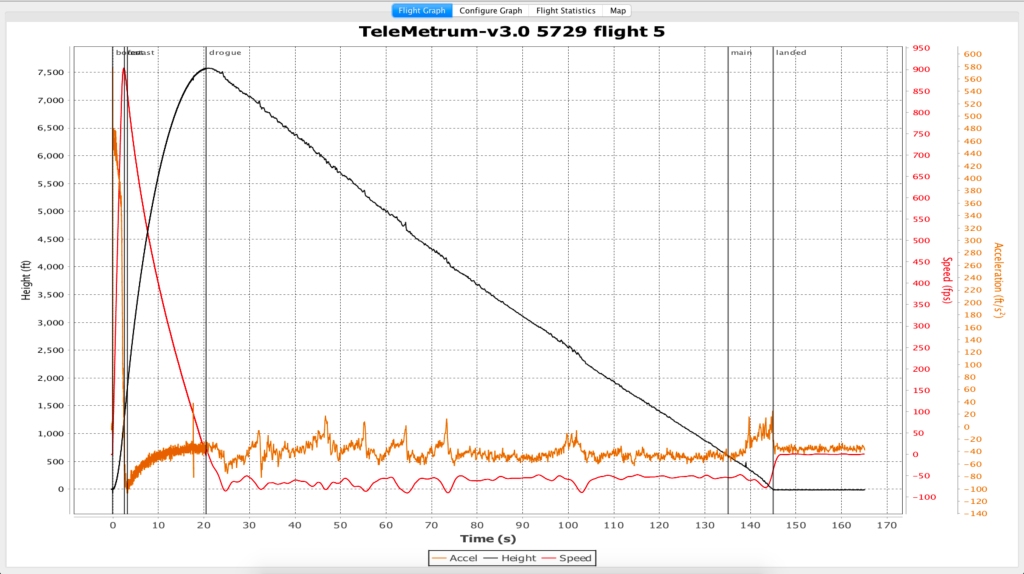Month: October 2020
Video: SBR 5.5″ L3 Fusion High Power Rocket, Part 1
Rocket flight data
Just to follow up on my last post, I wanted to provide some additional information and the actual flight data, and briefly explain what this all means, especially for all those folks reading this who are not familiar with anything related to rockets or flight computers. And for anyone who has significant experience flying rockets, you may find the below information interesting as well, without any explanation!
As a starting point: a flight computer is basically a very small circuit board that you put inside your rocket, and it has a bunch of neat built-in gadgets to measure exactly how high the rocket went, and how fast, and what interesting events happened when. I’ll explain more below.
This is the relevant flight data for the flight I mentioned in my last post, which went over one mile high:

So what does all of this mean?
First of all, it means that the rocket flew to a maximum height of about 7,579 ft – you can see this in “maximum height.” This measurement is made by a barometer taking air pressure readings in the flight computer, starting at ground level on the launch pad, and then many times while it’s in flight. There’s also a GPS chip on this flight computer and you can see it also independently measures the height using GPS, but I’m just going to assume the lower value is more likely correct.
The flight computer also records the maximum speed, which in this case was 904 feet per second (fps), which is equivalent to Mach 0.8, or a little bit slower than the speed of sound.
The total flight time was 145 seconds (just over two minutes), and there’s a further breakdown of how long the rocket spent going up and then coming back down.
The graph is even more intuitive:

This reflects the same data described above. The black line is the easiest to understand: it represents the rocket’s actual height over time. As is generally the case (unless you experience a catastrophic failure), the rocket zooms off the launch pad extremely rapidly and hits a maximum height early (here, just over 7,500 ft, as you can see from the black units to the left side), and then after parachutes deploy, it descends more slowly.
The red line is speed (extremely high at first and then plummets quickly), and the orange or gold line is acceleration. Both of these units are off to the right side of the graph.
It’s definitely fun to build and fly a rocket, but with modern flight computers and the ability to record all kinds of really precise data, you can really geek out on this stuff. How high can I fly? How fast can my rocket go? Is it descending at the right speed, or do I need a bigger (or smaller) parachute next time? This can really help refine your building and flying skills through a trial and error process, because you have access to reliable data. And needless to say, this can also help you find your rocket if you lose it because it lands really far away out of sight. In that situation, you’ll find the GPS coordinates onboard to be incredibly useful!
NAR Rocket Science Achievement Award
The National Association of Rocketry (“NAR”) has established a “Rocket Science Achievement Award” program, which currently has three categories of awards:
- Mile Marker
- Faster Than Sound, and
- Data Downlink.

The awards are pretty straightforward: to achieve Mile Marker, you need to fly a rocket to at least 1 mile (5,280 ft), and you can get additional awards for 2 or 3 miles, or as many as you’d like, in one-mile increments. To achieve Faster Than Sound, you just have to fly a rocket at a speed that is Mach 1.0 or higher. And the Data Downlink award involves real-time telemetry for data beyond just basic altitude and acceleration.
For any of these awards, you have to have documentation of the flight data, including a copy of the data file from a commercial flight computer. If you submit this documentation and it’s accepted, you’ll be awarded a high quality printed certificate and your name will be added to the NAR website, which is pretty cool.
I recently achieved the Mile Marker award when I flew my Darkstar Extreme rocket to 7,579 ft AGL. I plan on even higher flights in the future, of course, and I’d like to try to achieve an award in each of the three categories that NAR established. The data downlink one should be the most interesting and will require a bit of creativity.
In case you’re interested, the award page is here!
